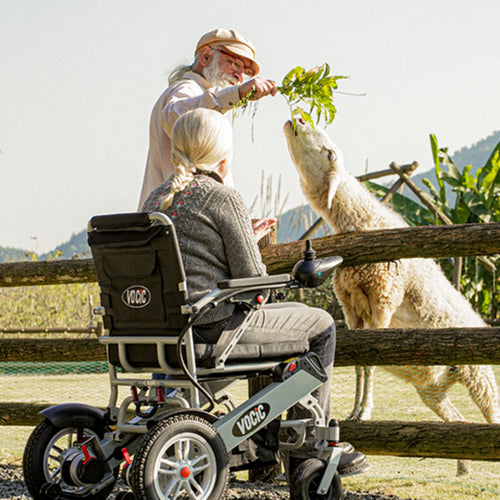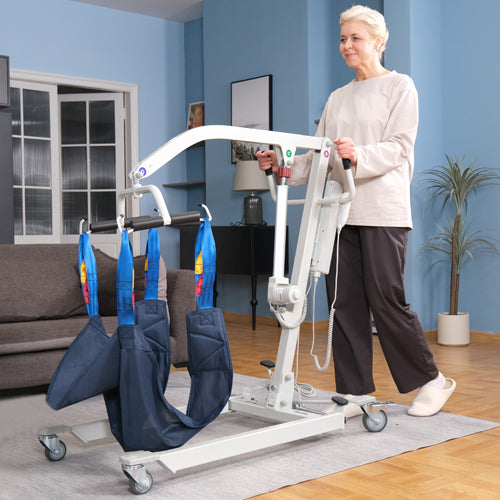Mobility scooters offer independence, but their use on roads raises questions. Understanding regulations, safety precautions, and local laws is crucial. Let's explore whether mobility scooters belong on the road.
What are mobility scooters?

Mobility scooters are battery-powered devices designed to assist individuals with mobility impairments. These scooters serve the purpose of providing a means of transportation for those who may have difficulty walking long distances or standing for extended periods. They are commonly used by individuals with disabilities, older adults, and people recovering from injuries.
Types of mobility scooters
There are various types of mobility scooters, each designed to cater to specific user needs. These include travel scooters, which are lightweight and easily transportable, as well as heavy-duty models that offer enhanced stability and weight capacity for outdoor use.
General rules for mobility scooters on the road
There are some important considerations regarding legal requirements and safety measures when using mobility scooters on public roads.
In many areas, including the United States, there are specific laws governing the use of mobility scooters on public roads. Understanding these regulations is essential to ensure compliance with local codes and to promote safe use.
For individuals using mobility scooters, knowledge of these laws allows users to confidently navigate public spaces while adhering to established guidelines.
Regional Regulations for Mobility Scooters on the Road

In the United States, regulations regarding mobility scooters on public roads vary by state, reflecting the diverse approaches to accommodating individuals with mobility impairments.
1. California's approach to mobility scooters
California has established specific guidelines for the use of mobility scooters on public roads. These regulations outline speed limits, designated pathways, and safety requirements for scooter users. Additionally, California law mandates that mobility scooters must yield to pedestrians and exercise caution when navigating through pedestrian zones.
2. Ohio and New Jersey: Public streets and paths
In Ohio and New Jersey, mobility scooter users are permitted to operate their devices on public streets and pathways designated for pedestrian use. However, these individuals must adhere to specified speed limits and prioritize pedestrian safety while utilizing their scooters in these shared spaces.
3. Comparing US laws with other countries
When comparing US laws governing mobility scooter usage with those of other countries, notable differences emerge. While some nations have stringent regulations mirroring those of certain US states, others adopt a more relaxed approach to integrating mobility scooters into public spaces.
4. Unique regulations around the world
Internationally, unique regulations govern the use of mobility scooters, reflecting cultural attitudes toward accessibility and mobility. For instance, certain European countries prioritize inclusive infrastructure that accommodates various modes of mobility devices, including foldable mobility scooters, while also emphasizing pedestrian safety in shared spaces.
Safety Tips for Using Mobility Scooters on the Road
As individuals with mobility impairments navigate public roads and pathways using mobility scooters, prioritizing safety is paramount. Implementing essential safety measures and adhering to best practices can significantly enhance the overall experience and promote a secure environment for all road users.
1. Essential safety gear for mobility scooter users
When operating mobility scooters on the road, users must equip themselves with the necessary safety gear to mitigate potential risks. The following safety accessories are recommended for mobility scooter users:
- Helmets
- reflective clothing
- lights
Wearing a helmet while using a mobility scooter can provide vital head protection in the event of an accident or collision. Additionally, donning reflective clothing and utilizing lights on the scooter enhances visibility, especially during low-light conditions or inclement weather.
2. Importance of visibility and protection
Enhancing visibility through reflective clothing and lights not only safeguards the user but also alerts other road users to the presence of the mobility scooter. Prioritizing protection by wearing a helmet underscores the commitment to personal safety while navigating public spaces.
3. Navigating roads and sidewalks safely
Effectively maneuvering mobility scooters on roads and sidewalks requires a comprehensive understanding of safe practices that promote harmonious interaction with other pedestrians and vehicles.
Crossing streets and interacting with traffic
When crossing streets, mobility scooter users need to exercise caution and adhere to designated pedestrian crossings whenever possible. Utilizing crosswalks ensures enhanced visibility to motorists, reducing the risk of accidents. Additionally, maintaining awareness of surrounding traffic flow contributes to safe navigation across roadways.
Sidewalk etiquette and pedestrian areas
While utilizing sidewalks, mobility scooter users need to respect pedestrian areas by yielding to individuals on foot. Adhering to designated pathways and refraining from obstructing pedestrian walkways fosters a cooperative environment conducive to the shared use of public spaces.
Navigating the Road: Best Practices for Mobility Scooter Users

1. Planning your route: Avoiding hazards
When embarking on a journey with a mobility scooter, it is essential to plan the route carefully to ensure a smooth and safe travel experience. Utilizing modern technology can significantly aid in this process, offering valuable insights into scooter-friendly paths and potential hazards.
2. Using maps and apps to find scooter-friendly paths
Modern mapping applications and navigation tools provide invaluable assistance in identifying routes that are conducive to mobility scooter usage. These resources often feature accessibility options, allowing users to pinpoint pathways that accommodate mobility scooters and offer minimal obstacles. By leveraging these digital tools, individuals can chart their course with confidence, knowing that they are following designated routes suitable for their mode of transportation.
3. Identifying and avoiding high-traffic areas
Another crucial aspect of route planning involves steering clear of high-traffic zones that may pose challenges for mobility scooter users. By consulting real-time traffic data and local knowledge, individuals can proactively avoid congested areas, minimizing exposure to potential risks while optimizing their travel efficiency. This proactive approach fosters a more seamless journey, allowing individuals to navigate the road with greater ease and peace of mind.
4. Legal responsibilities and rights of mobility scooter users
Familiarity with local laws regarding mobility scooters enables individuals to responsibly assert their rights while advocating for equal access and inclusion within the community. This awareness also fosters a sense of confidence in individuals as they navigate public spaces, knowing that their rights as mobility scooter users are protected by established legal provisions.
While upholding one's rights as a mobility scooter user, it is equally important to be responsible to other road users. Considerate behavior such as yielding to pedestrians when appropriate and obeying designated paths helps create a cooperative environment conducive to safe travel for all who share public space.
By prioritizing mutual respect and understanding, mobility scooter users play an active role in fostering positive interactions on the road while fulfilling their legal obligations as responsible community members.
Conclusion
By becoming familiar with these legal frameworks, individuals can confidently navigate public spaces while safeguarding their rights as mobility scooter users. In the meantime you can take a look at 6 safety tips for operating your mobility scooter. Prioritizing safe and responsible use of these devices helps create a safe environment for all road users and promotes harmonious coexistence on shared roads.
When advocating for road accessibility and inclusivity, education and awareness of mobility scooter regulations need to be promoted. Providing comprehensive resources on local laws can help regulate how people use e-scooters on the road.
Additionally, advocating for accessibility requires providing equal opportunities for individuals who use mobility scooters and creating an environment that is inclusive of all modes of travel, while prioritizing the safety and cooperation of all road users.









